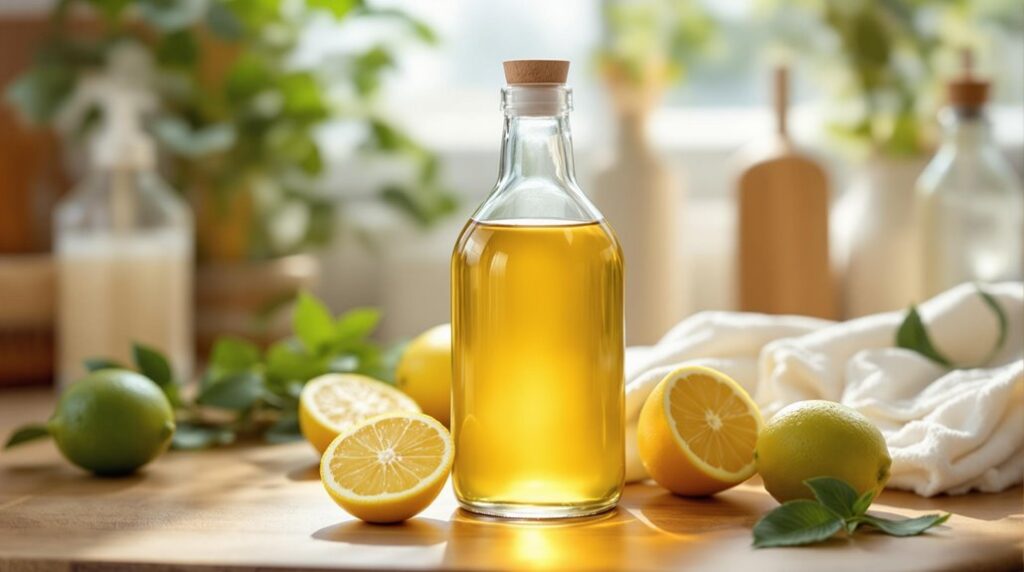I’ve discovered that malt vinegar isn’t just for fish and chips—it’s one of the most powerful natural cleaning agents hiding in your pantry. The acetic acid in malt vinegar cuts through grease, dissolves mineral deposits, and eliminates odors without the harsh chemicals found in commercial cleaners. What makes it particularly effective compared to white vinegar is its slightly higher acidity and robust cleaning power. Let me show you how this humble ingredient can transform your entire cleaning routine.
Key Takeaways
- Malt vinegar’s natural acetic acid effectively dissolves grime, grease, and mineral deposits without harsh chemicals or toxic residues.
- Mix equal parts vinegar and water to steam-clean microwaves, descale coffee makers, and disinfect kitchen surfaces naturally.
- Soak showerheads in diluted vinegar solution and spray tiles to remove soap scum and limescale buildup effortlessly.
- Pour vinegar down drains, add to laundry rinse cycles, and run through dishwashers to eliminate odors throughout your home.
- Avoid using vinegar on natural stone surfaces, electronics, or with bleach to ensure safe, eco-friendly cleaning practices.
Why Malt Vinegar Works As A Natural Cleaning Agent
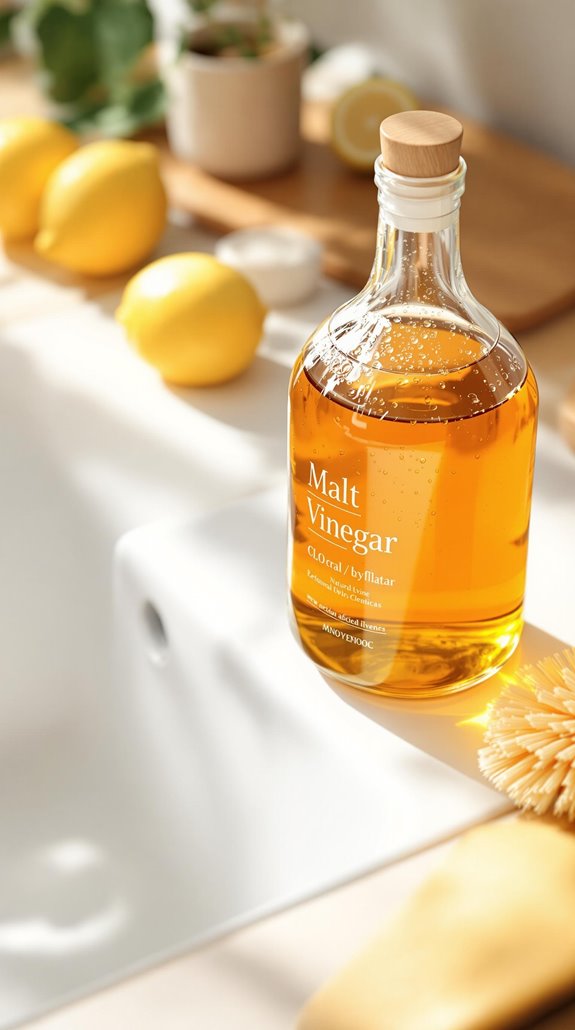
When you’re looking for an effective cleaning solution that won’t harm your family or the environment, malt vinegar’s natural acetic acid content makes it a powerful alternative to harsh chemical cleaners. I’ve found that its mild acidity effectively dissolves grime, grease, and mineral deposits without damaging most surfaces. The natural fermentation process creates a non-toxic, biodegradable solution that’s safe around kids and pets.
What makes malt vinegar particularly effective is how its acidic properties break down alkaline-based residues like soap scum and hard water deposits. It penetrates porous surfaces to lift embedded dirt while disrupting bacterial cell membranes through acidification. Unlike synthetic cleaners, it evaporates completely without leaving streaks or chemical residues, making it perfect for glass surfaces and food-prep areas. This cost-effective solution makes it an accessible cleaning option for most households compared to expensive commercial cleaning products.
Kitchen Cleaning Solutions With Malt Vinegar
Since kitchens face constant challenges from grease, food residue, and bacterial contamination, malt vinegar’s versatility makes it an ideal all-purpose cleaning solution for this high-traffic area. I’ll show you how to tackle your kitchen’s toughest cleaning challenges effectively.
For appliances, I use equal parts malt vinegar and water in my microwave—heat until steam forms, then wipe clean. Coffee makers and kettles benefit from half-water, half-vinegar descaling cycles. Stainless steel surfaces shine when sprayed with vinegar and wiped with soft cloths. Regular cleaning can help prevent buildup that may lead to more significant issues over time.
I disinfect counters, cutting boards, and fridge shelves with straight vinegar. For stubborn stains, I scrub coffee cups with equal parts salt, baking soda, and vinegar. Wine stains disappear when saturated with vinegar, left standing, then rinsed. The acetic acid in malt vinegar provides the cleaning power that breaks down grease and grime throughout your kitchen.
Bathroom Deep Cleaning Techniques
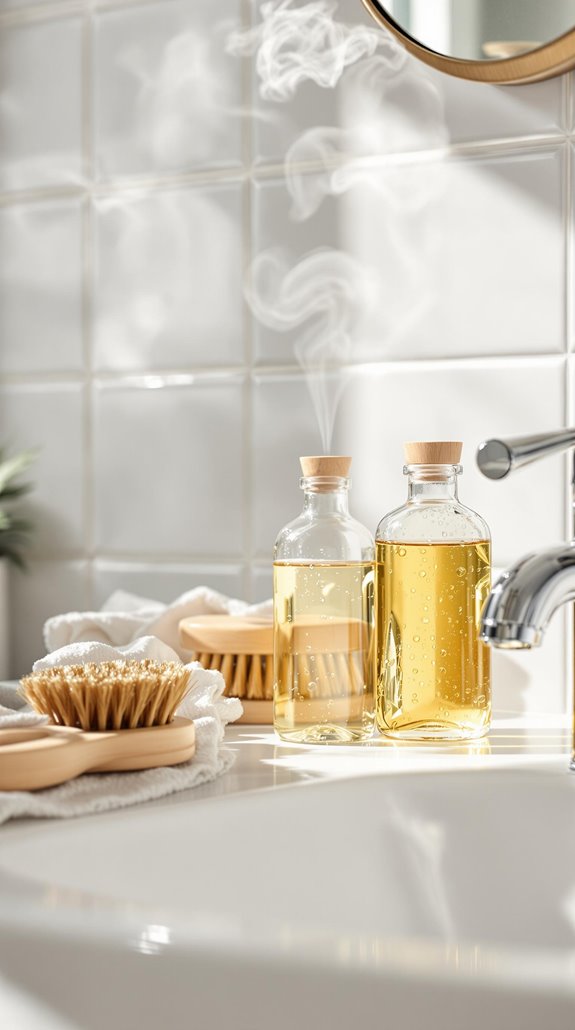
Bathrooms demand more intensive cleaning than most rooms due to constant moisture, soap residue, and mineral buildup from hard water. I’ll share my proven malt vinegar techniques that’ll transform your bathroom into a sparkling sanctuary.
For shower deep cleaning, I soak showerheads in equal parts malt vinegar and water for one hour to dissolve stubborn limescale. I spray diluted vinegar solution on tiles and taps, removing soap scum effortlessly. Glass doors get streak-free shine with my one-to-ten vinegar-water mixture.
I tackle toilet stains by sprinkling baking soda inside the bowl, then scrubbing with a vinegar-dipped brush. For persistent stains, I pour undiluted vinegar and let it work overnight. However, I always test on hidden areas first to ensure the vinegar won’t cause any adverse reactions on different bathroom surfaces.
My drain declogging method combines boiling water, vinegar, and baking soda—it’s incredibly effective for clearing blockages naturally.
Odor Elimination Throughout Your Home
Beyond surface cleaning, malt vinegar excels at eliminating stubborn odors that plague every home. I’ve discovered it’s particularly effective in kitchens where cooking smells linger. Pour one cup down drains and let it sit for 30 minutes to destroy foul odors. For garbage disposals, I process vinegar ice cubes to clean blades while deodorizing.
In laundry rooms, I add half a cup to the rinse cycle to neutralize odors and soften fabrics naturally. It’s especially effective on mildew-smelling towels and sweaty synthetic materials.
For appliances, I wipe refrigerator shelves with vinegar to eliminate food odors, and run my dishwasher with a cup placed in the bottom rack. This tackles buildup while freshening the entire appliance without harsh chemicals. Since malt vinegar is biodegradable, it’s an environmentally responsible choice that won’t harm your home’s ecosystem.
Specialized Cleaning Tasks Made Simple
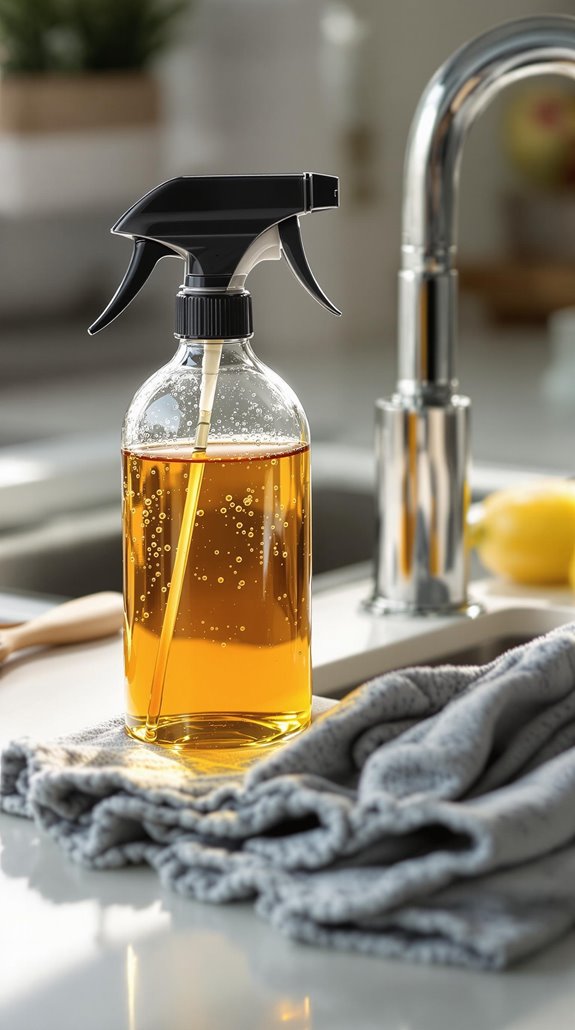
Three specialized cleaning challenges consistently frustrate homeowners: stubborn limescale, tarnished metals, and streaky glass surfaces. I’ve discovered that malt vinegar tackles these tough jobs with surprising effectiveness.
For descaling, I mix equal parts water and malt vinegar for kettles, then run this solution through coffee makers to dissolve mineral buildup. Tea-stained mugs soak clean in just fifteen minutes. Additionally, maintaining cleanliness can help prevent mouse infestations in your home.
Glass surfaces respond beautifully to vinegar-water spray, eliminating streaks on windows and shower doors. I always test inconspicuous areas first to prevent damage.
Metal maintenance becomes simple when I soak rusted tools in diluted malt vinegar. Cast iron and stainless steel items benefit from these treatments, though I limit soaking time and rinse thoroughly afterward. The acetic acid content effectively breaks down rust and corrosion on metal surfaces. These specialized applications prove malt vinegar’s versatility beyond basic cleaning.
Safety Tips For Using Malt Vinegar
While malt vinegar offers remarkable cleaning power, I’ve learned that proper safety precautions prevent accidents and protect both surfaces and health. I never mix malt vinegar with bleach or ammonia, as these combinations create toxic chlorine gas and chloramine vapors that can cause serious respiratory harm. I always keep cleaning products completely separate to avoid accidental mixing.
I avoid using malt vinegar on natural stone surfaces like marble and granite, as the acid causes permanent etching and damage. Electronics, delicate fabrics, and porous materials also stay off my vinegar cleaning list due to potential corrosion and staining risks. I’m particularly cautious with washing machines, as vinegar can damage rubber seals and hoses over time, especially in front-load washers.
For safe application, I dilute malt vinegar with water in a 1:1 ratio, ensuring proper ventilation during use and storing it away from incompatible chemicals.
Cost-Effective Cleaning Recipe Combinations
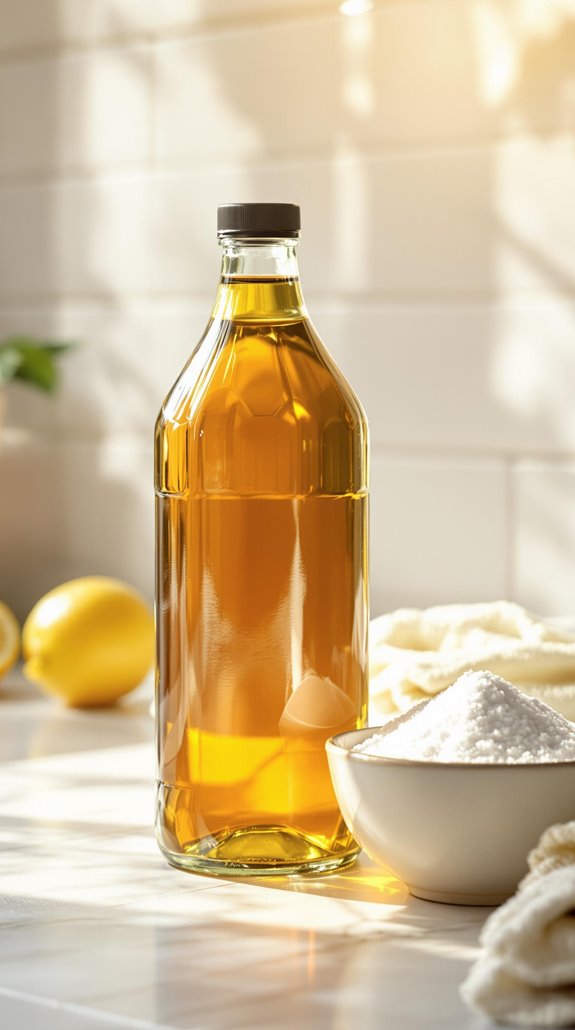
Since malt vinegar costs considerably less than commercial cleaners, I’ve developed dozens of recipe combinations that deliver professional results without breaking the budget. My go-to all-purpose blend combines equal parts malt vinegar and water – this single mixture tackles countertops, tiles, and glass surfaces effectively.
For heavy-duty cleaning, I create a powerhouse paste using 60ml baking soda, 1 tablespoon liquid detergent, and vinegar. This combination handles tough grime while costing pennies per application. I also make large batches of deodorizing spray by mixing 1 cup malt vinegar, 1 cup water, and 10 drops lemon essential oil. When cleaning cutting boards, I spray them with undiluted vinegar for maximum sanitization.
These versatile recipes replace multiple expensive products. You’ll save hundreds annually while achieving superior cleaning results that rival any commercial brand.
Conclusion
I’ve shown you how malt vinegar transforms your cleaning routine with simple, effective solutions. You’ll save money while protecting your family from harsh chemicals, and you’re helping the environment too. Start with basic vinegar-water mixtures for everyday tasks, then experiment with specialized recipes I’ve outlined. Keep these techniques handy—you’ll reach for malt vinegar instead of expensive commercial cleaners. Your home stays sparkling clean using this single, powerful natural ingredient.
References
- https://theseepcompany.com/blogs/the-seep-blog/can-you-use-distilled-malt-vinegar-for-cleaning
- https://tekacleaning.co.uk/blog/distilled-malt-vinegar-for-cleaning/
- https://tekacleaning.co.uk/blog/can-you-use-malt-vinegar-for-cleaning/
- https://www.idealhome.co.uk/house-manual/cleaning/can-you-clean-with-malt-vinegar
- https://blog.fantasticcleaners.com/can-you-use-malt-vinegar-for-cleaning/
- https://www.healthline.com/health/cleaning-with-vinegar
- https://www.sffchronicles.com/threads/589066/
- https://www.sarsons.co.uk/how-to/cleaning-with-vinegar/
- https://nodighome.com/2024/12/11/christmas-spiced-cleaning-vinegar-recipe/
- https://madeleineolivia.co.uk/20-diy-natural-cleaning-recipes-hacks-tips/

